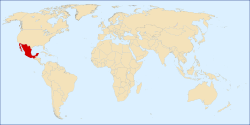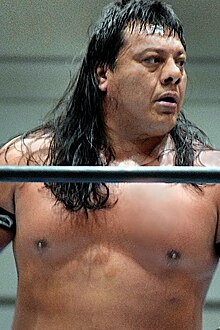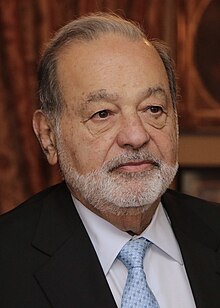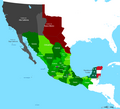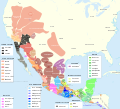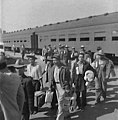Portal:Mexico
|
The Temple of Warriors at Chichen Itza, Mexico
¡Bienvenido! Welcome to the Mexico portal
Mexico, officially the United Mexican States, is a country in the southern portion of North America. It covers 1,972,550 km2 (761,610 sq mi), making it the world's 13th-largest country by area; with a population of almost 130 million, it is the 10th-most-populous country and the most populous Spanish-speaking country. Mexico is organized as a federal constitutional republic comprising 31 states and Mexico City, its capital. It shares land borders with the United States to the north, with Guatemala and Belize to the southeast; as well as maritime borders with the Pacific Ocean to the west, the Caribbean Sea to the southeast, and the Gulf of Mexico to the east.
This is a Featured article, which represents some of the best content on English Wikipedia.
Maya stelae (singular stela) are monuments that were fashioned by the Maya civilization of ancient Mesoamerica. They consist of tall, sculpted stone shafts and are often associated with low circular stones referred to as altars, although their actual function is uncertain. Many stelae were sculpted in low relief, although plain monuments are found throughout the Maya region. The sculpting of these monuments spread throughout the Maya area during the Classic Period (250–900 AD), and these pairings of sculpted stelae and circular altars are considered a hallmark of Classic Maya civilization. The earliest dated stela to have been found in situ in the Maya lowlands was recovered from the great city of Tikal in Guatemala. During the Classic Period almost every Maya kingdom in the southern lowlands raised stelae in its ceremonial centre. Stelae became closely associated with the concept of divine kingship and declined at the same time as this institution. The production of stelae by the Maya had its origin around 400 BC and continued through to the end of the Classic Period, around 900, although some monuments were reused in the Postclassic (c. 900–1521). The major city of Calakmul in Mexico raised the greatest number of stelae known from any Maya city, at least 166, although they are very poorly preserved. (Full article...)Selected article -Ciudad Juárez (US: /sjuːˌdɑːd ˈhwɑːrɛz/ syoo-DAHD HWAR-ez, Spanish: [sjuˈðað ˈxwaɾes] ; "Juárez City"), commonly referred to as just Juárez (Lipan: Tsé Táhú'ayá), is the most populous city in the Mexican state of Chihuahua. It was known until 1888 as El Paso del Norte ("The North Pass"). It is the seat of the Juárez Municipality with an estimated population of 2.5 million people. Juárez lies on the Rio Grande (Río Bravo del Norte) river, south of El Paso, Texas, United States. Together with the surrounding areas, the cities form El Paso–Juárez, the second largest binational metropolitan area on the Mexico–U.S. border (after San Diego–Tijuana), with a combined population of over 3.4 million people. Four international points of entry connect Ciudad Juárez and El Paso: the Bridge of the Americas, the Ysleta–Zaragoza International Bridge, the Paso del Norte Bridge, and the Stanton Street Bridge. Combined, these bridges allowed 22,958,472 crossings in 2008, making Ciudad Juárez a major point of entry and transportation into the U.S. for all of central northern Mexico. The city has a growing industrial center, which in large part is made up by more than 300 maquiladoras (assembly plants) located in and around the city. According to a 2007 New York Times article, Ciudad Juárez was "absorbing more new industrial real estate space than any other North American city". In 2008, fDi Magazine designated Ciudad Juárez "The City of the Future". (Full article...)Selected picture Mural by Diego Rivera, of the Pre-Columbian Aztec city of Tenochtitlan.Palacio Nacional, Mexico City. image credit: Wolfgang Sauber/freedom of panorama
This is a Good article, an article that meets a core set of high editorial standards.
José Gutiérrez Hernández (born March 1, 1972), better known by his ring name Último Guerrero (Spanish for Last Warrior), is a Mexican luchador (or professional wrestler), who works for Consejo Mundial de Lucha Libre (CMLL). He is not related to the lucha libre legend Gory Guerrero or any of his children; "Guerrero" in this case is the Spanish word for warrior and not the surname of the character. On September 19, 2014, Último Guerrero lost a Lucha de Apuestas match to Atlantis, after which he was forced to unmask and reveal his birth name. He is a former holder of the CMLL World Heavyweight Championship, NWA World Historic Middleweight Championship, the CMLL World Tag Team Championship (where he and Dragón Rojo Jr. are the longest reigning tag team champions) and CMLL World Trios Championship on multiple occasions. Guerrero is a charter member of the stable of wrestlers known as Los Guerreros de Infierno / Los Guerreros de la Atlantida and has also made appearances for Total Nonstop Action Wrestling (TNA) in the United States. In TNA where he was part of Team Mexico, which won the 2008 World X Cup. Guerrero is the only wrestler to win the Torneo Gran Alternativa tournament three times and the CMLL Universal Championship tournament twice. He is also part of the CMLL booking committee. (Full article...)Selected biography -Carlos Slim Helú (Spanish pronunciation: [ˈkaɾlos esˈlin eˈlu; - esˈlim -]; born 28 January 1940) is a Mexican business magnate, investor, and philanthropist. From 2010 to 2013, Slim was ranked as the richest person in the world by Forbes business magazine. He derived his fortune from his extensive holdings in a considerable number of Mexican companies through his conglomerate, Grupo Carso. , the Bloomberg Billionaires Index ranked him as the 11th-richest person in the world, with a net worth of $105 billion or about 7% of Mexico's GDP, making him the richest person in Latin America. Slim's corporate conglomerate spans numerous industries across the Mexican economy, including education, health care, industrial manufacturing, transportation, real estate, mass media, mining, energy, entertainment, technology, retail, sports and financial services. However, the core of his fortune derives from telecommunications, where he owns América Móvil (with operations throughout Latin America) and the Mexican carrier Telcel and ISP Telmex, a state-run-gone-private company which maintained a virtual monopoly for many years after Slim's acquisition. He accounts for 40% of the listings on the Mexican Stock Exchange, while his net worth is equivalent to about 6% of Mexico's gross domestic product. As of 2016, he is the largest single shareholder of The New York Times Company. (Full article...)
In the news
Selected fare or cuisine -Tostilocos (also Dorilocos) are a popular Mexican antojito (street food) that consist of a varied mix of ingredients that usually includes Tostitos or Doritos tortilla chips, topped with cueritos (pickled pork rinds), cucumber, jícama, lime juice, hot sauce, chamoy, chili powder, salt, and "Japanese peanuts" (sometimes referred to as "cracker nuts"). The dish was first conceived in the late 1990s by street vendors in Mexico. In the 21st century, Tostilocos are now commonly sold by street vendors, stadium vendors, and at Mexican juice bars in both Mexico and the Southwestern United States. (Full article...)
General imagesThe following are images from various Mexico-related articles on Wikipedia.
CategoriesTopicsRelated portalsWikiProjectYou are invited to participate in WikiProject Mexico, a WikiProject dedicated to developing and improving articles about Mexico. Associated WikimediaMore portals | ||||||||||




